London's overlooked rail project
- Published
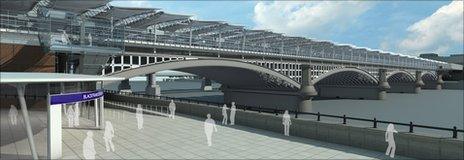
The upgraded line will boast London's only mid-river station
It is a massive engineering project that will deliver a mainline railway through the heart of London with Tube-like service frequency.
It will connect multiple regional destinations on either side of the capital for the first time with a direct rail service.
Yet it has been beset by controversy over its route, worries about its funding, and years of delay.
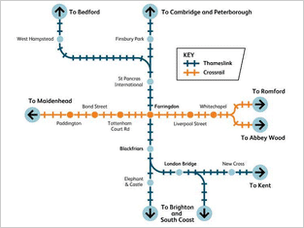
Thameslink will become an equally significant part of the southeast's railway infrastructure
Crossrail, right?
Nope. It's the Thameslink upgrade.
'Gilded lily'?
The north-south rail-link, first opened up in the 1980s, has been somewhat overshadowed by its more glamorous east-west cousin, even though the new-and-improved Thameslink will become an equally significant part of the southeast of England's railway infrastructure.
"Crossrail's nice and shiny because it's a brand new line," says Gareth Edwards, editor of the London Reconnections blogsite, external. "People tend to see Thameslink as gilding the lily. But actually it's a lot more than that."
The £6bn project - a third of the cost of Crossrail - will transform the cross-capital route.
Peak train frequency will increase from the original 7-8 minutes, to 4 minutes currently, and 2-3 minutes by the end of the decade.
And the current Brighton-to-Bedford route will add Cambridge, King's Lynn, Ashford and Eastbourne as destinations.
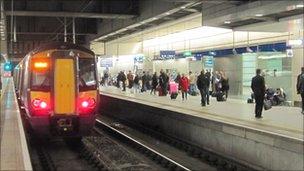
St Pancras, the only central London station finished so far, echoes the brutalist chic of the Jubilee line
"It will be a really fast and reliable turn-up-and-go rail service," boasts London assembly member Caroline Pidgeon. "Once it's up-and-running, people will say, 'Oh my God, this is amazing.'"
She points out the new London Overground network as an example of how introducing a high-frequency metro-style train service on an old line can unleash an astonishing amount of suppressed demand.
Indeed, the route is already overcrowded, and the project is set to deliver a switch from 8-car to 12-car trains by this December.
"50 stations are being lengthened," says Simon Brooks of Network Rail, the company managing the project. "In all, we're building 4km of new platform."
Underneath the arches
But the upgrade has not been without controversy.
Thameslink has driven a coach and horses through the middle of Borough Market.
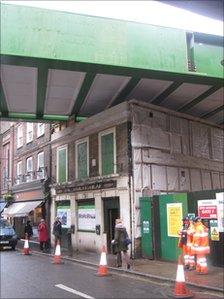
The new viaduct has driven a coach and horses through Borough Market
Around two-dozen Dickensian listed buildings - including a large swathe of the Victorian covered market itself - are being demolished to make way for a new viaduct.
Local opposition was one factor behind the decades-long delay to a project that was originally conceived around 1990 and fate-temptingly named "Thameslink 2000".
"People in the area thought: 'I've got a railway already, I've got loads of trains, I don't need any more,'" says Ms Pidgeon, who used to be on Southwark council. "They just saw it as a big nuisance, and understandably so."
Yet Network Rail had little choice.
If it wants to run a high frequency service, then Thameslink cannot afford to share its lines with anyone else.
And Borough Market is a notorious railway bottleneck, with the same tracks serving trains into Charing Cross and Cannon Street.
Deciding where to put the new viaduct - which will free up the old viaduct for Thameslink-only services - cannot have been much fun.
The historic Wheatsheaf pub has lost its top floor, while the Globe pub now finds itself ignominiously wedged in between the brick arches of the old line and the steel frame of the new.
"Wherever they put it, they were going to hit a significant number of listed buildings," says Mr Edwards of London Reconnections.
Hard cheese
But Ms Pidgeon says most locals have moved on, and few complain about the work in progress.
That certainly seems to be the mood among the market's traders.
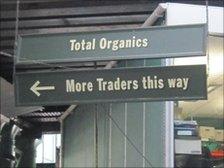
The temporary relocation has hurt business for some market traders
"It's never as black as they paint it," says Maria, who now runs her cafe at a temporary plot right by the construction site.
Her original cafe was compulsorily purchased by Network Rail, only for her new site within the market to fall within the viaduct's footprint, forcing her to relocate again.
But she is far from bitter, praising their responsiveness to "teething problems" such as the odd power cut.
"Considering the size of the job, it is surprisingly quiet," she says. "They're working now. Can you hear anything?"
The only din is from a train rumbling out of London Bridge.
"When you consider the immensity of the work being undertaken, it is amazing there is still a functioning market at all," says another long-time trader, whose cheese stall - like many others - has been rehoused during the interim in what used to be the carpark.
He has nothing but admiration for the engineers.
And although his relocation to a more obscure corner of the market has sapped business, he treats it as par for the course.
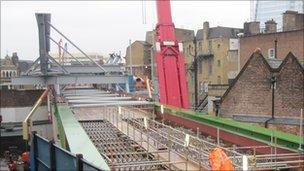
The new Borough High St bridge is being assembled on top of the viaduct before being shunted into place
The traders seem to accept that it is impossible to please everyone.
A case in point is the work currently going on to put a bridge across Borough High Street.
To avoid impeding traffic on the main road, the bridge is being assembled on top of the viaduct before being shunted across into place.
But one trader said this just means they have periodically had to block off Stoney Street instead - an important access point for deliveries to the market.
Joined-up thinking
Perhaps the most eye-catching part of the Thameslink project to-date is the nearly completed relocation of Blackfriars station onto the railway bridge straddling the Thames.
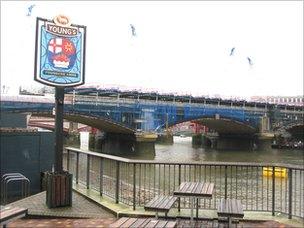
Business has been slow at the Founder's Arms pub since building work severed the Thames path
"Soon we will have the sexiest railway station in the UK, and I intend to make it our unique selling point," says Carol Anderson, events director at the Mermaid conference centre that borders the carcass of the old station.
But she concedes that the station's temporary closure has hurt business in the meantime.
The aesthetic impact of the new station is actually just a happy by-product of a concept that is entirely practical - namely to give access to the station from both sides of the river.
That means it will only be a short walk for tourists from the Tate Gallery, the Globe Theatre and other South Bank attractions.
Ms Pidgeon at the London assembly has been lobbying for the station to be renamed "Blackfriars and Bankside" in recognition of its dual location.
"It's going to be a big plus," says the duty manager at the Founder's Arms, a riverside pub conveniently sat between Blackfriars Bridge and the Tate.
She says 90% of their business comes from tourists that happen across the pub as they walk the Thames path.
They plan a refurbishment to help them accommodate the expected crowds of customers, although the building work has ironically killed business in the short-term, as the riverside pathway has been cut off for two years.
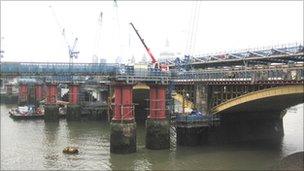
Blackfriars' new terminus platforms will be built on top of the bright red piers of the first railway bridge
Shifting the station onto the bridge also helps Network Rail solve a logistical problem.
The new Blackfriars will be reconfigured so that trains terminating there will not have to cross the path of the through-trains.
In another startling innovation, these terminus platforms will be built on top of the bright red piers that are all that remain of the first Blackfriars railway bridge, demolished in 1985.
And creative thinking has also gone into the construction itself.
Barges have been moored under the bridge so that supplies can be brought in by river, avoiding the need to clog up the roads.
Gordian knot
Two stops up the line, Farringdon station is set to become one of the most important interchanges in the country.
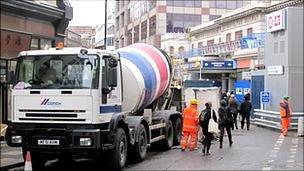
Farringdon station is perhaps the trickiest construction site on the line
Sitting just north of the City financial district, it will provide the nexus between Thameslink and Crossrail - not to mention the Metropolitan line - making the station a doubly busy destination.
That is certainly the hope of Kate, proprietor of the Castle pub, which faces what is now an enormous building site.
"It's going to pump huge amounts of sales in," she says, noting plans to build a new shopping centre at the station.
She bought the lease on the pub two months ago in anticipation of exactly that.
But it has also been doubly painful during the building works.
She says business is down by half, and complains about numerous unannounced weekend station closures, which have killed trade from revellers heading for the local nightclubs - one of which has already shut down.
"Farringdon is hugely complex," explains Network Rail's Simon Brooks. "For example, there are three different electrical supply systems at the station."
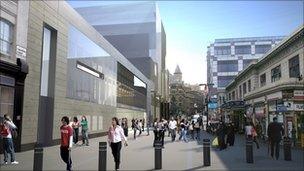
Crossrail intends to build retail space on top of the new joint ticket hall (left) to help fund their project
The Thameslink work has had to incorporate a lot of stage-setting for the deeper Crossrail line, such foundation construction and dropping lift shafts.
To help co-ordinate the work with the local community, Mr Brooks said they hold quarterly meetings with businesses and community representatives at Farringdon.
But on-site co-ordination has also been challenging, according to Mr Edwards at London Reconnections, with Network Rail, Crossrail and Transport for London often giving mixed messages about who is responsible for what.
'Catalyst'
Farringdon illustrates an important distinction between Crossrail and Thameslink.
While Crossrail has had to attract a big chunk of private sector money - hence the shopfloors being built above the new Crossrail ticket office - Thameslink has been entirely funded by the government.
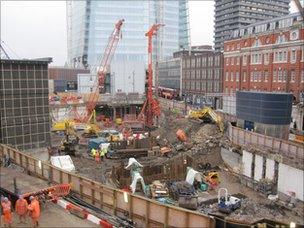
The route coincides with several major private redevelopments, such as London Bridge's Shard
For a perilous few months last year, it looked as if the axe was about to fall on the project after the Treasury chose to spare Crossrail from the spending review.
But in the end Thameslink was confirmed in full, albeit with a widely anticipated extra year's delay to 2019.
Its reprieve may be partly because the improved rail service is a big selling point of many major commercial redevelopments in the capital, such as at Elephant and Castle in the south, or Brent Cross to the north.
Mr Brooks claims the line upgrade has acted as a catalyst for urban regeneration.
For example, the last stage of the project is the complete rebuild of London Bridge station, to increase the number of trains that can pass through the station.
That work is intimately connected with the construction of the Shard - the UK's tallest skyscraper - right next door.
Indeed, the Shard's developers are funding construction of a new bus terminal and station concourse with direct access into the tower.
"Developers like to put a picture of a new station, and facts and statistics about the number of trains, in their brochures," notes Mr Edwards.